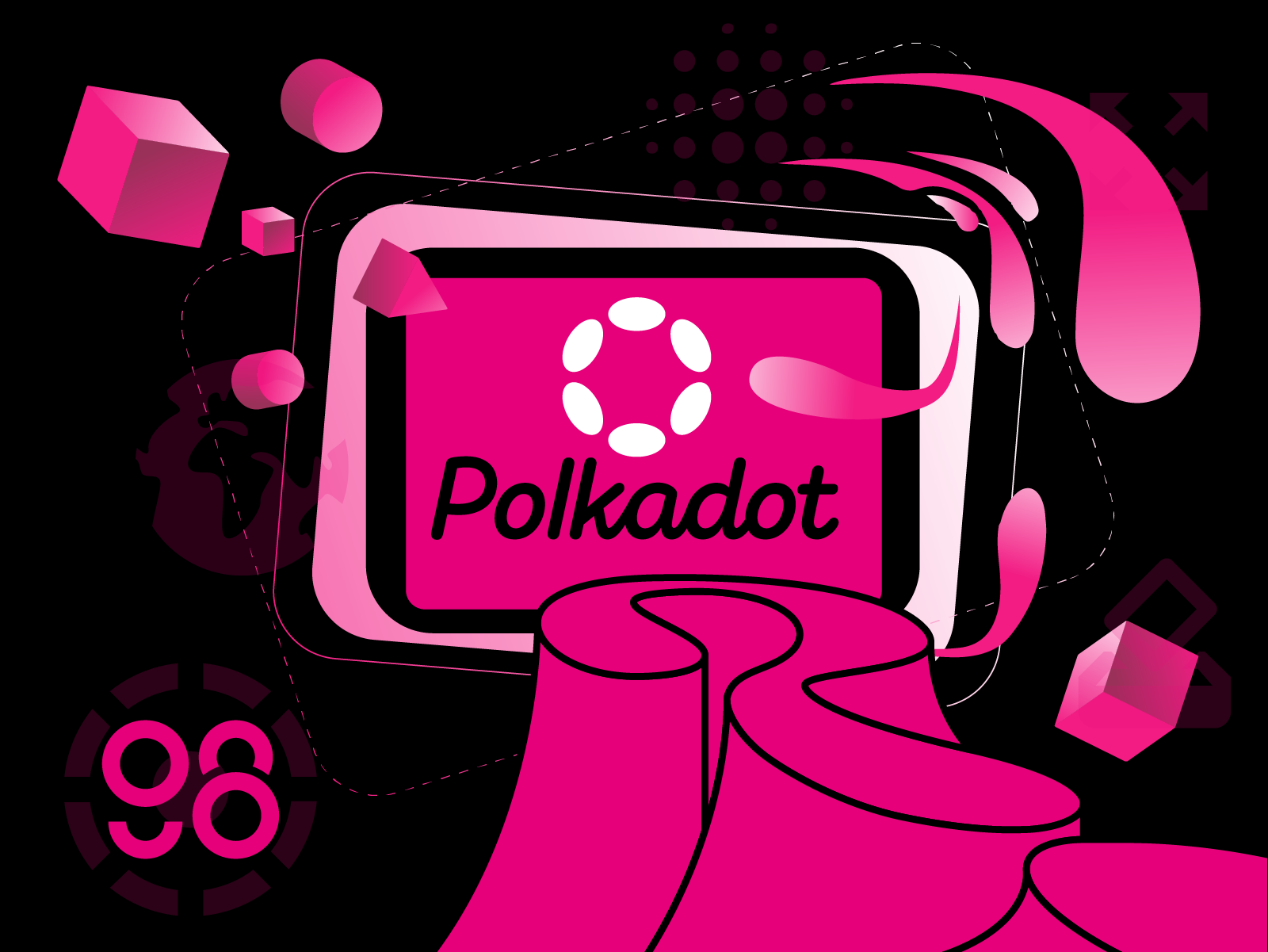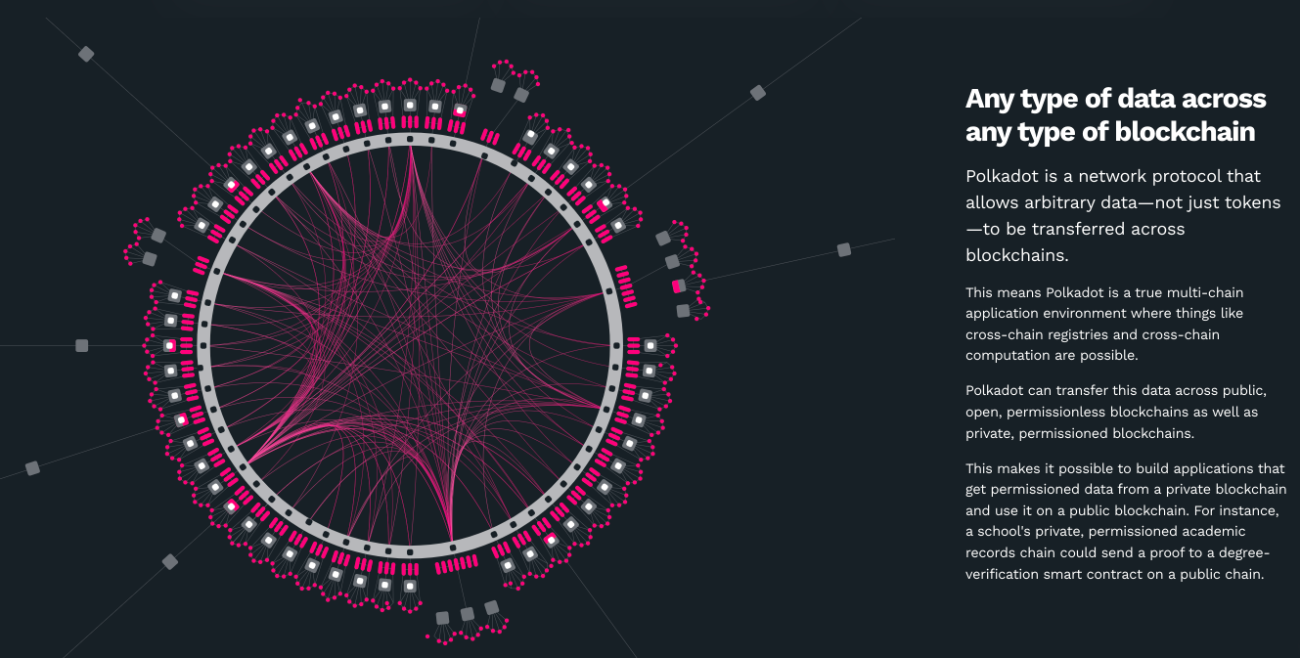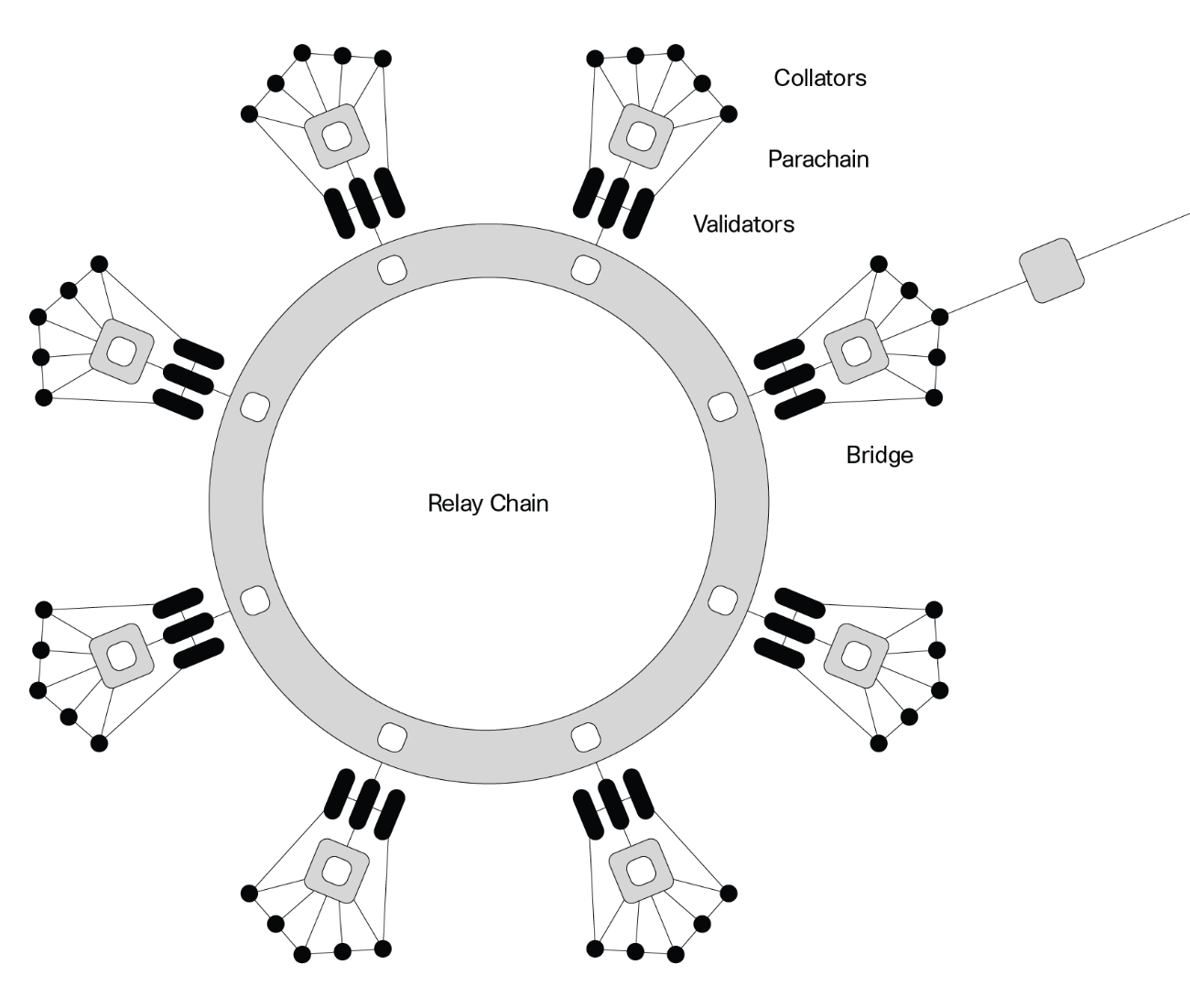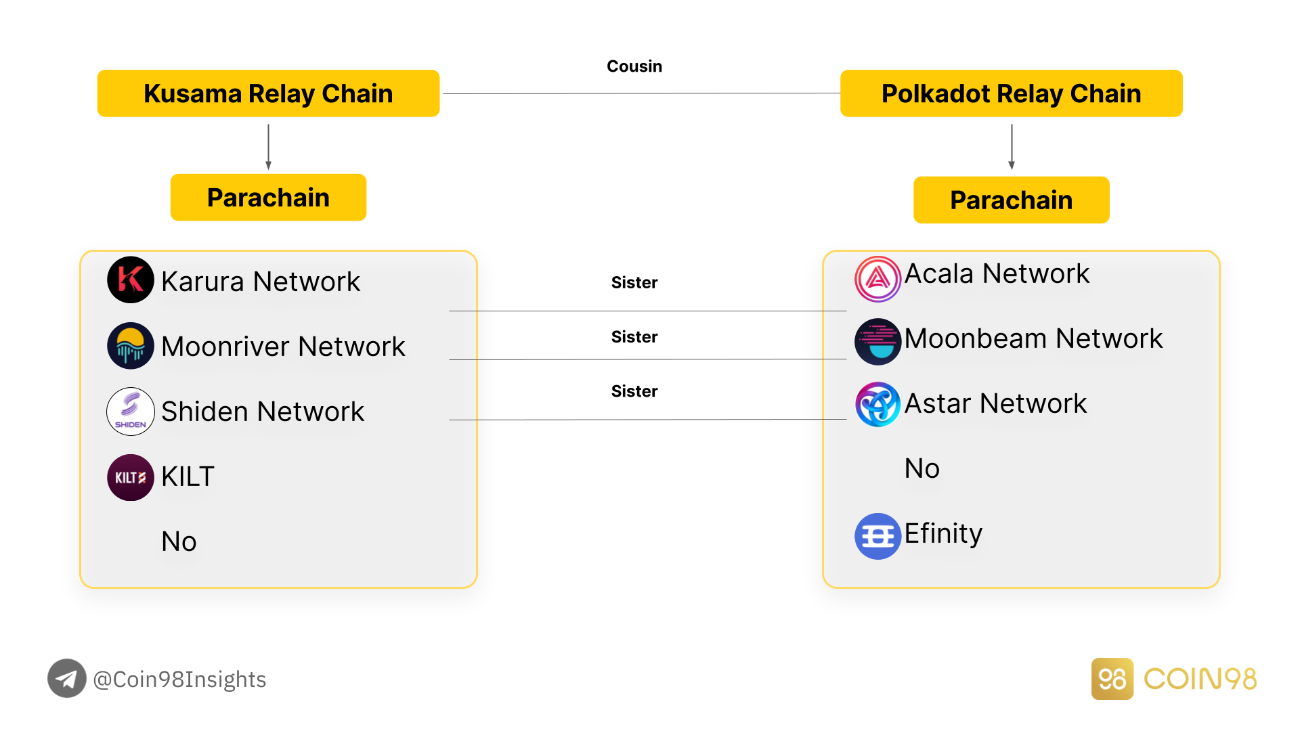What is Polkadot (DOT)? Everything you need to know about DOT token

Gavin Wood, co-founder of Ethereum, noticed that no blockchain is perfect, and development will put more and more operational pressure on each blockchain. So let's make it easier for people to build the blockchain they want, and at the same time create a network to connect those chains to upgrade scalability. Therefore, he created Polkadot to become a network for many different layer 1 platforms like Ethereum to run on.
What is Polkadot?
Polkadot allows blockchains to connect with each other to share data and form a decentralized network. If chains like Ethereum, Solana, Polygon are layer 1 platforms, then Polkadot can be understood as a layer 0 platform that connects layer 1 platforms.
Polkadot's vision is to create a "Decentralized Web - Decentralized Network". Polkadot focuses on solving two main problems of Blockchain: Interoperability and Scalability.

How does Polkadot work?
Polkadot is a Relay Chain acting as the main chain of the system, and it uses a sharded model, called “parachains”. Transactions in these parachains are allowed to be processed in a parallel instead of sequentially
Let's take a look at a few key terms that will be repeated throughout this article.
Network structure
Relaychain: Is Polkadot's Central Chain, responsible for connecting Validates to Parachains.
Parachain: Parachain can be understood as the position of layer 1 platforms (know as blockchain) when connected to Polkadot's Relay chain. However, Parachain is not necessarily a Blockchain, it can be a Dapp or a Data Structure, as long as it can be verified by the Validators.
To be a parachain on Polkadot, the project must participate in the Parachain Slot Auctions in order to raise funds in the DOT coins. On Polkadot, the parachain slot will be leased for two years, while on Kusama, it will be leased for one year.
Parathread: Similar to Parachain but with a pay-as-you-go model ⇒ More savings for blockchains that don't need a constant connection to the network.
Bridges Chain: It can be envisioned as a bridge between Polkadot Network and other Blockchains, providing interoperability between networks.

Parachains are free to create and implement their own mechanisms. They are directly connected to the Relay Chain, allowing them to access Polkadot's throughput while also sharing the same security as its Relay Chain.

Take a simple example, if Polkadot is a giant computer, parachains are like applications that are in physical memory and highly available. Whereas, Parathreads are like applications that are on disk and can be copied into memory when needed.
Substrate: Substrate can simply be understood as a framework that makes it easier to build Blockchain. Projects built with Substrate can run on Polkadot, but projects built on Substrate can exist as a standalone platform.

Components of the Polkadot network

Polkadot's network consists of 4 main components:
- Validators: Producing Relay Chain blocks, responsible for validating and adding new blocks to the Relay Chain.
- Collators: Monitor transactions occurring on Parachain and send proof to Validators to maintain network security.
- Nominators: Nominating Validators, is like delegating your shares to other Validators.
- Fisherman: Monitor the network and report bad behaviors to Validators. Collators and any parachain full node can perform the Fisherman role.
Polkadot Noteworthy Features
Perhaps you might wonder why Polkadot follows the above structure. Here are the reasons:
Cross-Chain Composability: Cross-chain Composability can contribute to the unity of the liquidity across blockchains.
Sushiswap is now active on 13 distinct blockchains. It appears to be doing well, with a TVL of $6 billion. When users want to trade on Fantom, however, the liquidity is set at $9 million, and there is no option to maximize liquidity on other blockchains.This is the biggest barrier for crypto users, because the separation between chains creates a disruption in the adoption of crypto products.
Polkadot is built as a network layer 0, allowing Layer 1 platforms like Ethereum to work together on the same network. As the crypto market expands with many new chains appearing, Polkadot is built with the purpose of becoming the next step in the crypto market, connecting single pieces into a unified whole.
The born of Kusama

Web3 Foundation has created another Replay Chain named Kusama, which runs in parallel with Polkadot Relay Chain. It will be an early, highly experimental version of Polkadot presenting real economic conditions. Therefore, Kusama is riskier and wilder than those of Polkadot.

Typically, projects will choose to deploy their products in both two Relay Chain by simultaneously running two parachains. Moonriver Network and Moonbeam Network, for instance, were developed by the same team, however, Moonriver is a parachain on Kusama whereas Moonbeam is a parachain on Polkadot.
The illustrated picture below will clearly show the relationship between Kusama & Polkadot, Parachain & Parachain

There are still some projects that aim to run only on a single Relay Chain, such as Efinity only running on Polkadot and KILT only on Kusama.
What makes Polkadot special?
Polkadot was born to solve the following problems:
- Heterogeneous Sharding: Different blockchains can run in the same network.
- Scalability: The sharding model allows parallel procession of many transactions, eliminating the problems that existed on individual chains such as Ethereum due to sequential transaction processing.
- Upgradeability: Blockchain upgrades sometimes require forking the network, which involves a lot of time and effort. Also, in the case of hard forks, a unanimous community decision is another issue.The Polkadot network supports blockchains to upgrade themselves without the need to chain fork.
- Cross-Chain Composability: Polkadot supports cross-chain communication. Segments can deliver messages to communicate, exchange value, and share functionality. This is the biggest barrier for crypto users, because the separation between chains creates a disruption in the adoption of crypto products.
Polkadot is built as a network layer 0, allowing Layer 1 platforms like Ethereum to work together on the same network. As the crypto market expands with many new chains appearing, Polkadot is built with the purpose of becoming the next step of the crypto market, connecting single pieces into a unified whole.
Detailed information about DOT token
Key Metrics DOT
- Token Name: Polkadot.
- Ticker: DOT.
- Blockchain: Polkadot.
- Token Standard: Updating…
- Contract: Updating…
- Token Type: Utility, Governance.
- Total Supply: 1,120,800,075 DOT.
- Circulating Supply: 1,039,850,942 DOT.
DOT Token Allocation
- Polkadot Auction: 50%
- Web3 foundation: 30%
- Further Pre-Launch Distributions: 20%

DOT Token Sales
Funding Round: Initial Coin Offering with total 5M allocated at $28.8 per token
Salt Round: 500,000 DOT with 120$ per token
DOT Token Release Schedule
Updating…
DOT Token Use Cases
DOT is Polkadot’s native token which has the following use cases:
- Staking to do Validator.
- Parachain Auction: When a project wants a slot for Parachain, they will have to go for an auction. When the auction is successful, this DOT number will be locked.
- DOT is the governance token of Polkadot.
How to buy DOT token
Coin98 Exchange is a decentralized exchange (DEX), a Multi-chain liquidity aggregator that offers users a wide variety of DeFi services (swap, stake, lend, borrow,...) through intuitive and simple interfaces.
You can trade DOT directly on Coin98 Exchange by following the steps below at: https://exchange.coin98.com/
Step 1: Connect the wallet via Coin98 Extension.
Step 2: Select Token to trade:
- Search DOT.
- If the result is not displayed, you can paste the address of the DOT in: 0x7083609fCE4d1d8Dc0C979AAb8c869Ea2C873402
Step 3: Enter the number of tokens you want to swap.
Step 4: Adjust Gwei gas and slippage according to demand.
Step 5: Browse the transaction (approve) to complete.

How to store DOT token
You can store the DOT coin on Coin98 Super Wallet with the following simple operation:
Step 1: At the main interface, select Receive.
Step 2: Enter DOT in the search box.
Step 3: Copy the DOT wallet address and send the DOT token to this address

Roadmap
- PoA: Web3 Foundation will launch Polkadot in Proof of Authority mode.
- NPoS: During Nominated Proof of Stake, the network will run with a decentralized set of validators
- Governance: elect the first Council and Technical Committee and start accepting public proposals
- Enable Balance Transfers: Polkadot allows balance transfers.
- Current Phase: Parachain Rollout
- Future Upgrades: Polkadot upgrades currently under development include upgrades to XCMP (Cross-Chain Message Passing) and the launch of parathreads. These and any subsequent upgrades can be enabled by Polkadot’s on-chain governance community once development, testing, benchmarking, and auditing are complete.
Kusama had 17 parachains up till now, and these parachains were very active, with many Dapps launched on them. Polkadot Relay Chain, on the other hand, has only recently begun to open auctions on November 11th, 2021, with three parachains already winning the slot. This is the stage when the network is officially used and projects on Polkadot can be realized.
Team, Investors and Partners
Team
- Gavin Wood, co-founder of Ethereum, the founder of the Solidity programming language, wrote the Yellow Paper for the Ethereum Virtual Machine, and served as the first Chief Technology Officer (CTO) of the Ethereum Foundation.
- After leaving Ethereum in 2016, Wood co-founded Parity Technologies (formerly Ethcore), a company that develops core infrastructure for Ethereum, Bitcoin, Zcash, and Polkadot; and then the Web3 Foundation, a nonprofit organization focusing on decentralized internet technology and infrastructure, starting with the Polkadot network. In short, Gavin Wood is the one who built up the foundation of the crypto market.

With that being said, WEB3 Foundation and Parity Technology were the first to support the development of the crypto world. Polkadot was supported in the aspects of finance, technology and system administration from WEB3 and Parity Technology, show the massive strength of Polkadot compare to other project on the market.
Investors
Polkadot has many investors who are hedge funds and venture capital, some of which are Three Arrows Capital, CoinFund, Kenetic Capital, Genesis Block, NGC. With the number of more than 50 investors, Polkadot is a project of great stature and strong guarantee.
Partners
Polkadot has an ecosystem, so the project has many partners; all projects participating in parachain or auctioning parachain slots are partners of Polkadot.
Similar Projects
Polkadot's direct competitor in building a network of layer 1 platforms is Cosmos. Up to the time of this article, it can be seen that Cosmos has had clearer activities than Polkadot when there have been many successful projects operating and developing on the Cosmos network such as Binance chain (BNB), Thorchain (RUNE) or Terra ( LUNA).
In comparison, Polkadot and Cosmos are in different stages; while the Cosmos network has been active for a while, Polkadot is still waiting for the parachain implementation. This network will need time, until the Polkadot ecosystem goes into operation, then we will have a clearer view of the differences between these two layer 0 networks.
Is Polkadot (DOT) a good investment?
I hope that you have understood what Polkadot is with the information mentioned above. This article should give you a deep insight into the project, so there is no financial advice. You should Do Your Own Research before conducting any investment and be responsible for your own fund.
However, Coin98 will provide some notable points about the project to give you the best overview to make your own decisions.
In the crypto market, there are more and more layer 1 platforms such as Solana, Polygon, Celo. The independent operation of current chains is having problems in usage barriers, scalability and asset portability. Polkadot was created to solve those problems, as layer 1 platforms built on parachain can focus more deeply on specific purposes such as gaming, DeFi or transactions, which is a significant change compared to the current blockchains that are all responsible for becoming one for all platforms.
Currently, the network on Polkadot is waiting for the parachain to be ready so that projects can start working on Polkadot, so the expectation about the potential of the project on Polkadot network is worth looking forward to.
Gavin Wood is the co-founder of Ethereum, we can understand him as one of the founders of the current crypto world, and Polkadot was built by Gavin to be the next evolution of the crypto market in the future. The fact that the project was born with a backer like Gavin Wood with the WEB3 foundation can be worth our trust.
Conclusion
Polkadot is built with the purpose to be the “Internet of blockchain”, allowing individual chains to operate on the same network, helping to solve the current problems of scalability, interoperability between different chains to make the application of crypto easier.
Because there is no perfect blockchain that can support all activities in the crypto world, Polkadot will help the development of chains become more specialized, creating an efficient network. Built by the people who know the best about crypto development, Polkadot's ability in the future is worth the trust.
You’ve been through an article about Polkadot. I hope it has helped you in gaining more helpful insight into this project and understanding its potential.